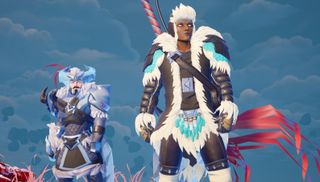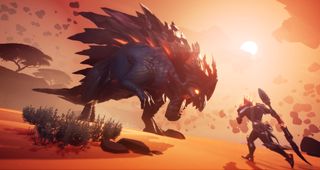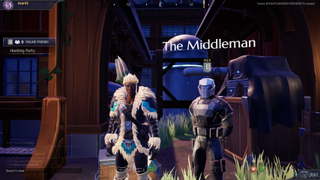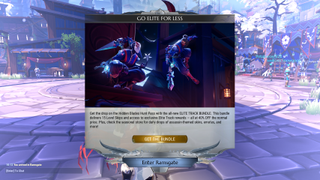It's hard to find much of a reason to play Dauntless over Monster Hunter: World
Snappy combat and some cool monsters still can't compare to Capcom's goliath.

Dauntless did not make a good first impression—actually, it was more like it did make a good first impression, and then had forgotten my name when we met again the next day. I first booted up this free-to-play alternative to Monster Hunter on Monday, used its surprisingly deep character creators to create a cartoony avatar I quite liked, and enjoyed its opening few moments. I went on a super basic introductory hunt, watched a couple cutscenes, and struggled through a few server connection errors before I could make it to the town hub. I crafted some armor, talked to a few vendors, and quit for the afternoon.
The next time I booted up the game, my character and progress had mysteriously vanished. I liked that character, dammit! Update: Phoenix Labs reached out to clarify that this had been a planned pre-launch account wipe, not the result of server issues.
It's been a rough launch week for Dauntless on the server front, with downtime and login queues across both PC and console. I think my character wipe was a fluke, from playing pre-launch on especially crashy servers. I haven't had that problem again, but I have had to wait in line just to get past the title screen. Because Dauntless is a free-to-play game, you have to be able to log in and connect to a server just to play solo. That's one of many reasons I have a hard time recommending Dauntless over Monster Hunter: World, a game you could play for hundreds of hours at the cost of $60 (or less on sale) without running out of new weapons to master.

I almost wrote off Dauntless in the first hour or two, but there is some real monster hunting to be had here, once you get past the server issues and its first few quests. The first few monsters I hunted were so boring and so easy to kill, especially in a group, that combat wasn't really that much fun. I was mindlessly clicking left- and right mouse, alternating light and heavy attacks, and dodging every so often. With a group of three other hunters I got thrown into matchmaking with, it was easy to kill one of these beasts in about five minutes, barely worrying about taking damage.
But it does get better. Once the training wheels came off I took on the Shrike and the Skarn, two monsters that were actually challenging with my low-level gear and had designs to rival Monster Hunter: World's imposing enemies. The Shrike is an owl-bear-thing that flings tornadoes across the field with its wings, leaps into the air to come down with a powerful ground pound, and honestly just looks cool as hell with these bright yellow eyes and glowing feathers. This is a creature I would not want to come face-to-face with in a forest, dark alley, or, really, anywhere. But beating his ass with a flaming sword I'd crafted from another monster was a great time.
Weapons in Dauntless feel great to wield. They're not as animation-heavy as weapons in Monster Hunter, even with the slower weapons like the hammer and axe. You move quickly, dodge with a satisfying snap, and can pound on the mouse to quickly execute flashy combos. Some weapons let you hold to charge up attacks, and each weapon has its own special mechanic to learn.
None of it feels as deep as Monster Hunter—granted, I've only played a few hours of Dauntless, so that could change some. But it's hard to see any of these weapons requiring the timing or positioning mastery of Monster Hunter's insect glaive or lance or transforming charge blade (they do have some distinct and creative charge/ammo systems, though, that are more interesting than Monster Hunter's simpler weapons).
The biggest gaming news, reviews and hardware deals
Keep up to date with the most important stories and the best deals, as picked by the PC Gamer team.
It's a fun alternate flavor, easier to pick up and play. The first few monsters demand nothing from you, but I started actually studying my move list and combo timing once I fought the Shrike and then the Skarn.
The Skarn, who I will now call Magic Rock Lizard, is visually totally different from anything I've fought in Monster Hunter: World, and that's really exciting. Magic Rock Lizard's outer shell can float into the air and reconfigure itself around its body, which is both a cool effect and a great fight mechanic. When the rocks shift into position on its right side, I know it's about to perform a sideways rolling attack. When the rocks snap off its body to reveal a pulsing charge of energy underneath, I learned (the hard way) that it's about to do a super powerful whirlwind attack that will take off half my lifebar if I'm close enough to be sucked in.
It was a fun fight, and actually challenging. I'm sure with a few equipment upgrades and a little more experience the Magic Rock Lizard will be a push-over, but that's the draw of these kinds of games: learning the ins and outs of a creature's abilities, and how to counter them, then powering up so much that they're eventually push-overs.
Dauntless can clearly offer that. But still, Monster Hunter: World is simply the deeper, bigger, richer game. And I'd rather pay up front for that depth than deal with the concessions of a free-to-play game.
Once when I booted up Dauntless, and once when I simply returned from a hunt, it threw up ads for its "ELITE TRACK BUNDLE." On the screen at the end of every hunt, it shows me how I'm not getting a bonus because I don't have the Fortnite-inspired Elite Hunt Pass. There is, of course, a premium currency, which you can use to shortcut through some of the crafting system.
Monster Hunter has cats that cook me gigantic steaks; Dauntless has this guy who wants me to spend $9.99 on Platinum. Yes, it's an unfair comparison, but only one of them fills me with joy.

And there are the little things, which may just be first-week problems, but dampened my experience nonetheless. Sometimes when I walk up to an NPC and hold the E key to talk to them (an annoying holdover of controller-first interface design), nothing happens. I keep holding it, and the little circular meter that indicates I've held the button down long enough stays full, but the conversation never triggers. I have to let go and press it again, and then it mysteriously works.
At one point, I entered matchmaking to hunt a fire beast called a Lesser Emberlane. A minute passed. Then two. Then three. By the time I hit five minutes, it was pretty obvious that something was wrong with the matchmaking; it was never going to match me with anyone. Adding insult to injury, a bug made it impossible for me to back out and start matchmaking again or do the hunt on my own. So I hit alt-F4, restarted the game, and waited in another login queue.

Quest dialogue is brief and boring, as if it were designed to be ignored by 90 percent of players. It probably was, but if it was more interesting, I might actually read it. Everything in Dauntless feels designed for players who want to get in and get out, from its streamlined matchmaking to spawning monsters within sight of a hunt's spawn location. I think one of Monster Hunter: World's most undercooked systems is the experience of finding a monster and initiating your attack—it's really much more a game of monster fighting than monster hunting. That could've been an opportunity for Dauntless to do something bold and intricate with the hunting experience, but instead it's even more straightforward. There's not much reason to explore.
Dauntless grew on me once I got past its most basic hunts, but it feels a bit too simple and a bit too free-to-play to thrive in a post-Monster Hunter: World world. I will give it major props, though, for supporting cross-platform play between PC, Xbox, and PlayStation. I can imagine that's been a complicating factor in the launch server issues, but it's cool to so seamlessly get matchmade with players across all three platforms, and I haven't had any lag or performance issues. Capcom should take note.

Wes has been covering games and hardware for more than 10 years, first at tech sites like The Wirecutter and Tested before joining the PC Gamer team in 2014. Wes plays a little bit of everything, but he'll always jump at the chance to cover emulation and Japanese games.
When he's not obsessively optimizing and re-optimizing a tangle of conveyor belts in Satisfactory (it's really becoming a problem), he's probably playing a 20-year-old Final Fantasy or some opaque ASCII roguelike. With a focus on writing and editing features, he seeks out personal stories and in-depth histories from the corners of PC gaming and its niche communities. 50% pizza by volume (deep dish, to be specific).
Most Popular

